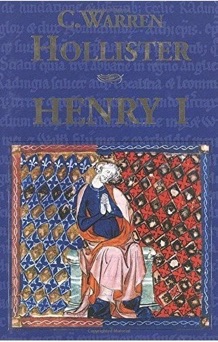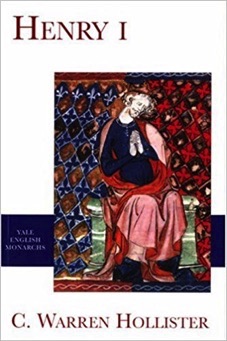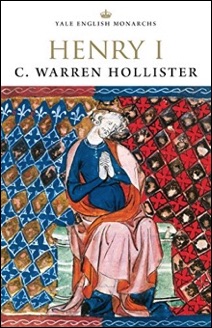Henry I (2001)
2001 Hardback
2008 Kindle (UK & USA)
This is the first biography of an important early king but it was nearly a lost work. It was added to the list of English Monarchs titles from the beginning, on the jacket of ‘William the Conqueror, the first book in the series published in 1964, yet it was ultimately published by Yale, not long afer they assumed ownership of the series. Professor Hollister was still working on this biography in the last years of his life but it was unfinished at the time of his death in 1997. Professor Hollister’s key points are that Henry I established the basis of the institutions usually attributed to Henry II, his grandson, giving firm and peaceful rule for decades. Yet tragedy intervened with the sinking of the White Ship, the most catastrophic maritime disaster in the middle ages. The loss of his only legitimate son and many of his court was both a personal catastrophe and a political one as it led to a succession crisis and the anarchy under King Stephen.
Hollister’s 2001 biography of Henry, in true English Monarchs style, is somewhat iconoclastic regarding what was then the standard view of Henry. Hollister contends that Henry's was a stable reign, and that his rule was much more in tune with the nobility than was his avaricious brother William Rufus. It was Rufus, he suggests, who was the aberration in government and that Henry was the consolidator of the Norman conquest. Hollister disagrees with Frank Barlow about Henry’s relationship with his barons and finds that Henry’s skilful handling of both foreign policy and domestic politics provided England, and indeed Normandy, with years of peace, wealth, and stability after the reign of Rufus who he paints as rather a villain in raiding the wealth of the church for his own benefit. While Barlow reviews this book as somewhat indulgent of Henry, Hollister takes great pains in the last third of the book to document the benefits his rule brought to England generally and in particular the church and his barons, and the application of law.
If you are unfamiliar with this king by the end of the book you will have read one of the great stories of English history. You’ll want to keep reading to see what happens next. This is the mark of a great story and a great story-teller. What luck that we have Edmund King’s biography of King Stephen waiting on the shelf. The sequel is every bit as interesting as the first instalment.
Marjorie Chibnall praised this work in Albion, Fall, 2002, Vol.34(3) as “...a deeply learned, readable, and witty biography, which provides a new assessment of an important reign” summing it up as “marvellous” and Frank Barlow in The American Historical Review, Volume 107, No. 1 (2002) had some reservations: that it is overlong and had a leisurely pace (a curious, observation as this book is not substantially longer than his own biography of William Rufus!); and that Hollister regards Henry and his government rather more indulgently that other historians, yet concluded that it was a major achievement.
Paul R. Hyams (Cornell University) in Speculum, Vol. 79, No. 1 (Jan., 2004) finds that the book possesses many strengths but also finds it lacking in its treatment of economics of the reign and also the concepts of feudalism that Hollister employs rather old-fashioned. More importantly, this "...shows all too well that the old feudal vocabulary impeded meaningful analysis."
The introduction is essential reading and it tells how the production of this book was troubled. Work of the book commenced in 1962 but first draft of it was lost in the Santa Barbara fire of 1990 and Hollister had to start again. Gravely ill in hospital in 1997 he doggedly dictated notes to assist those who might finish the book. The work to complete it was undertaken by by his doctoral student Amanda Clark Frost who saw its publication by Yale in hardback in June 2001 and paperback in 2003.
Book Number: 19



2003 Paperback
Further Reading
One brother is missing from the series - Robert Curthose, Duke of Normandy. The elder brother of both William Rufus and Henry I has one modern academic biography similar in style, scope and research to an English Monarchs book:
“Robert Curthose, Duke of Normandy c. 1050–1134” by William H Aird. (Boydell Press, 2008). ISBN 9781843833109. Dr. Bill Aird lectured in Medieval History at Cardiff University until 2011 and subsequently at the University of Edinburgh.
The book was reviewed in Speculum, Vol. 84, No. 4 (2009) by Constance B. Bouchard who says it will be the biography of Curthose for decades to come, adding that it is "...clearly written and thoroughly documented".
Dr. Aird also wrote a research paper on the early career of Anslem which can be accessed here.
Cover: The image is credited in the book as showing Henry mourning for the loss of his son after the White Ship disaster. The image comes from “a fourteenth-century manuscript” held by the British Library MN MS Cotton Claudius D.ii F.45v
Email for Comments | Sitemap | Main Book Page | Saxon/Pre-Normans | Normans | Angevins | Plantagenets | Tudors | Stuarts | Georgians
Henry I
By C. Warren Hollister (1930-1997)
Professor of History,
University of California, Santa Barbara
Series Editor: J.J. Scarisbrick